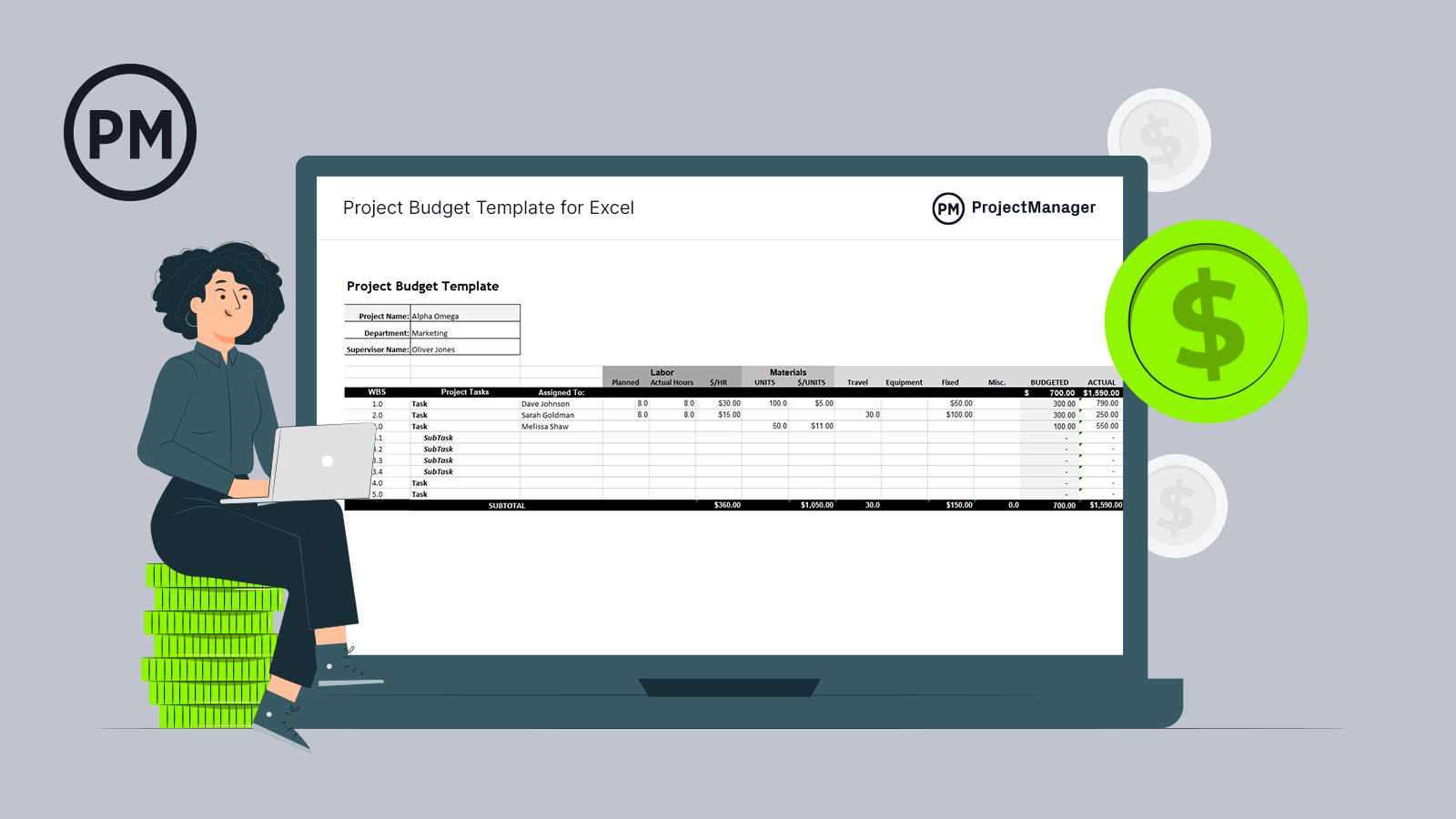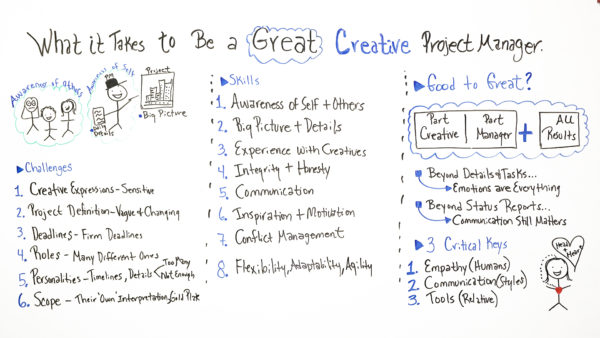Project managers work with many different types of professional teams. That project team influences how they lead a project, whether it’s a construction project manager or a creative project manager.
What Is a Creative Project Manager?
A creative project manager is a professional who’s tasked with leading a team of creative people. The creative team can be made up of graphic designers, interior designers, copywriters, UX designers, photographers or anyone who works in a creative field. A creative project manager leads creative projects or ones that have a component that deals with a creative element.
Creative project managers differ in some ways from more traditional project managers, but they share much in common. For example, they manage their projects and teams with project management software. ProjectManager is award-winning project management software that empowers creative teams to plan, manage and track their work in real time. Our multiple project views allow creative project managers and their teams to use the tools they want. Whether robust Gantt charts, visual kanban boards, task lists or a calendar view, all project views are updated simultaneously to keep everyone on the same page. Get started with ProjectManager today for free.

What Does a Creative Project Manager Do? 10 Key Responsibilities
You’ll see as we go through this list of the 10 key responsibilities of a creative project manager that it’s not that different from what a traditional project manager does. That’s because projects as diverse as creative, construction or manufacturing are all managed by the same processes, with a few variations, though the deliverables are different.
1. Managing Client Relationships
Every project has a client or stakeholders who are invested in the success of the project. They’re going to be interested in the progress of that project so it’s important to manage them. Communication is key. Scheduling regular status updates and providing them with project metrics to show that the project is progressing as planned is recommended.
2. Defining the Project Scope
The project scope defines the project goals, deadlines and deliverables. It creates the boundaries by which the project will operate and is critical for the project team and stakeholders to understand the project.
3. Creating a Project Schedule
The project schedule defines not only the deadline for the project but also the duration of each task that leads to the final deliverable. The project schedule organizes all the project tasks to ensure that they have the resources needed to execute them and are completed on time.
4. Estimating Project Costs
Even creative projects cost money. Before the project starts, the creative project manager must forecast all the project costs. To estimate these costs accurately requires knowing all the tasks and deliverables (a work breakdown structure helps identify these), the cost of the associated resources and referring to historical data to see how much similar projects cost.
5. Defining a Project Budget
The previous step will inform your budget, which details how you’ll spend what and when for the project. The project budget has to be approved by the project owner, client or stakeholder. Then it can be used as you execute the project to ensure your actual costs align with the budget.
6. Allocating Resources
Resources are everything a creative project manager needs to execute the project tasks, from the team to any equipment or raw materials they need. These resources must be sourced and scheduled to be available when and where they’re needed.

Get your free
Project Budget Template
Use this free Project Budget Template for Excel to manage your projects better.
7. Writing Creative Briefs
The creative brief is a document that outlines the approach and the deliverables for the creative project. It’s commonly found in marketing and advertising campaigns, where it’s used to connect the project to the larger business goals of the organization.
8. Leading Creative Workshops
A creative workshop is where the creative project manager and the project team can get together in a supportive environment to share new ideas openly. It can be a place to explore new ideas, select the best ones and build on them.
9. Ensuring Project Quality
As with any project, the deliverables must be produced on time and within budget. But if they don’t meet quality expectations, then they’re a failure. Therefore, quality assurance measures must be implemented to ensure that the deliverable meets quality standards. This involves inspection, identifying defects and repairing them as fast as possible to save time and money.
10. Promoting Team Collaboration
Getting your team to collaborate is a key team management skill as it’ll lead to them working more productively and creatively. There are ways a creative project manager can foster collaboration. They should share the company mission as a lodestar to follow, communicate clearly with the team and get their feedback, highlight the individual strengths of each team member, encourage creativity, use team-building exercises and keep conversations open, but honest.
Video: How to Become a Great Creative Project Manager
A creative project manager confronts many unique challenges. Jennifer Bridges, PMP, presents the skills you need when managing creatives, so you can go from good to great. (This creative project management software can help too!)
Thanks for watching! Here’s a screenshot of the whiteboard for your reference!

Jennifer began by saying that leading any team requires a great deal of both self-awareness and an awareness of others working with you. However, when working with a creative team, project managers must take a greater step. That’s because a project manager in this case needs to think not only of the project but the bigger picture of deliverables without losing sight of the daily details and the schedule.
Jennifer boiled down the pathway toward success as a creative project manager to the following:
- Be empathetic
- Communicate
- Have the right tools
Challenges of a Creative Project Manager
- When working with creatives, the deliverables aren’t widgets; they’re creative expressions. Your team will likely be more wedded to the product of their work than others might be. Being sensitive, especially when criticizing, is crucial when managing creative teams.
- Define the product. A creative project, or for that matter any project that is vague, is always going to be challenging. Make sure the product is clearly defined to keep everyone focused.
- Deadlines matter, so make sure that they’re firm and clearly communicated. Being creative doesn’t mean the work can go on forever; often restraints force more creative solutions.
- Roles can also be challenging, in that creative roles can be varied and even overlapping, so it’s something that must be given a close look.
- Creative personalities can be like other project team members, only taken to extremes. Some are too detail-oriented, while others aren’t detailed enough, so be aware of the people on the team.
- Finally, there’s project scope, which can be impacted by creative team members who have their own interpretation of what the project scope is.
What Skills Does a Creative Project Manager Need?
To recap, Jennifer went over the skills of any successful creative project manager:
- Be self-aware and aware of others.
- Have a view of the big picture and the details that make it up.
- Have prior experience with creatives, ideally.
- Have integrity and be honest.
- Excel at communications.
- Be inspirational in order to motivate the team.
- Have the ability to resolve conflicts peacefully and productively.
- Be flexible and have the agility to adapt when changes come.
If you’re interested in learning more about software that can help you become a creative project manager, take a free 30-day trial of ProjectManager.

